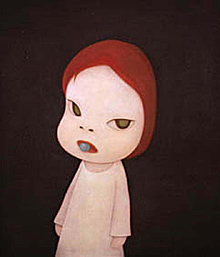7a
快楽主義とマニエリスム
Epicureanism and Mannierism
【本文確定】
バブル崩壊により不安定化した世相にさらに追い打ちをかけたのが、1995年1月17日に関西で起きた阪神淡路大震災と、同1995年3月20日に東京で起きたオウム真理教による地下鉄サリン事件でした。後者は、東京谷中に移転したSCAI The Bathhouseで3月10日から開催されていた奈良美智の新作展「深い深い水たまり」の会期中の出来事でした。
奈良美智はドイツや名古屋、東京ですでに発表を重ねていましたが、美術界に広く知れわたったのはこのSCAIでの個展がきっかけでした。当時同社の社員だった小山登美夫は、奈良美智の作品が美術ではなくイラストレーションに見えることを危惧していましたが、作家本人の「僕は自分の好きなものしか描かないよ」という言葉を聞いて納得しました*7a1 *7a2。すなわち「好きだから描く」ことを美術として肯定したのです*7a3。この瞬間、シミュレーショニズムとしての再現芸術に通底していた反芸術のドグマが消え去りました*7a4 *7a5。すなわち以後の時代は、規範や時代支配的なイズムを失って、「何でも有り」の多様性へとシフトしていきました。
規範無き時代には感覚的な快楽主義が跋扈します。『美術手帖』誌が「快楽絵画」という特集を組み、表紙に奈良美智を起用した1995年7月号の段階では、まだ無垢な具象画は奈良美智だけで、特集の大半は丸山直文や東島毅、堂本右美といった1980年代後半を引き継ぐフォーマリズム絵画でした*7a6。しかし翌1996年に村上隆がヒロポンファクトリーを立ち上げ、ミスターやタカノ綾らをプロデュースし世に出し始めると、いつの間にか美術界にはイラストレーションと区別のつかないゆるい具象画があふれかえっていました。これは世界的な傾向でもあり*7a7、また、落合多武のようにニューヨークの画廊と契約し、特に日本であるとかインターナショナルであるとかとは関係ないスタンスの作家も含まれていました。2000年9月号の『スタジオボイス』誌特集は「Honey Painting」と題され、日本と世界の快楽的な具象画が多数紹介されました*7a8。できやよいや加藤泉、坂千夏、青島千穂ら新人もぞくぞく登場し、2000年代にはますます盛んに快楽絵画が描かれるようになりました。
そして、時代支配的なイズムの不在は、一方では美術文脈において、内容を伝えるための技巧ではなく、技巧のための技巧主義すなわちマニエリスムの台頭を促しました*7a9。山口晃は、会田誠が若手を紹介した1997年の「こたつ派」展でデビューした典型的なマニエリスタです。彼は東洋美術の伝統技法を今日的奇想につなげましたが、小川信治は西洋絵画の伝統技法をシミュレーショニズム的な不在の表現に用い、より若手の鎌谷徹太郎はミクストメディアの画材開発からネオ・スーパーリアルを達成しました。天明屋尚や川島秀明といった名前も加えると、男性作家の多くは精緻な技巧を身上としたようでしたが、池田学ら一部の男性作家や、2005年前後に登場した冨谷悦子、鴻池朋子、野田幸江、松井冬子ら女性作家は、増殖的でキモワル風味の細密画でした。彫刻におけるマニエリスタとしては、「幽体の知覚」を追求しメディア作品にも力量を発揮する小谷元彦を筆頭に、反古典主義的な棚田康司やエフェメラルで繊細な宮永愛子、映像インスタレーションではさわひらきや小瀬村真美も挙げておきます*7a10。
快楽主義的な奈良美智の作品に、マニエリスムの要素を見て取ることも可能です。初期の表現主義的なタッチが捨て去られたあと、画面がより丁寧かつ精緻な技巧で仕上げられるようになったからです。と同時に、マニエリスムのもうひとつの側面であるキモワル風味も、意地悪そうな子供というモチーフから引き出されていました。巷では「こわい」と「かわいい」を一語にした「コワかわいい」という語がこの時期に登場しましたが、奈良美智が描くマニエリスムと快楽主義の同居した子供のキャラクターもしばしばコワかわいいと形容されました*7a11 *7a12。
時代支配的なイズムの不在は、他方では美術文脈から離れ、社会問題やごく私的な事項を題材とすることを可能にしました。前者には、社会的正義 (ポリティカル・コレクトネス) の頭文字からPCアートと呼ばれたものもありました。従軍慰安婦問題を扱った嶋田美子、「障碍の美術」の和田千秋、あるいはデジタルカウンターの作家として評価確立後の宮島達男が取り組む「時の蘇生」柿の木プロジェクト等が挙げられます。後者の私的なアートとしては、ちっぽけな自分をえんえんと吐露するドローイングや日常生活の延長としてのインスタレーションが表現方法として一般化し*7a13、写真では荒木経惟が「写真私情主義」と打ち出した一方で*7a14、HIROMIX、蜷川実花、長島有里枝らの私的写真がガーリー・フォト(女の子写真)と呼ばれ注目されました。彼女たちの輩出を助けたのはレンズ付きフィルム(使い切りカメラ)の発展で、巷ではプリクラ (アトラス「プリント倶楽部」他) が流行りました。デジタルカメラの普及直前のことでした。
西洋も含めて循環史観的な見方をするならば、1930年代や1970年代にもあった多様性時代の再来として1995年以後を解釈することができます。それぞれ先行する反芸術という規範、すなわち1930年代は直前のダダ、1970年代は直前のネオ・ダダ、1995年以後は直前のシミュレーショニズムという時代支配的なイズムの後退から惹起されたものでした。芸術の多様性はそれなりに豊穣で幸福ともいえますが、時代としてのダイナミズムには欠けるという見方もできます。また、2001年にアメリカ同時多発テロ、2003年にイラク戦争がありましたが、それでも多様性時代の骨格は変わらなかったようにも思います。1995年以後の美術状況を私は当時、「良くも悪くもかつてのエコール・ド・パリ程度」と形容しました。揶揄の気持ちも少しはあったかもしれません*7a15。
【第一版のまま】The then shaky social conditions brought about by the collapse of the so-called "bubble economy" was attacked by the great earthquake in Hanshin-Awaji in Kansai area which hit on January 17, 1995, and the sarin attack on Tokyo's subways on March 20 by Aum Shinrikyo. The latter occurred during Nara Yoshitomo's exhibition "In the Deepest Puddle" which gained a favorable review at SCAI THE BATHHOUSE which moved to Yanaka, Tokyo.
【第一版のまま】Solo exhibitions by Nara had already been done several times in Germany, Nagoya and Tokyo, but this exhibition was the one which was able to seize the opportunity to get well known in the art world. Koyama Tomio, the staff at SCAI at that time, was apprehensive that Nara's work might have been seen as illustrations and not art, but he was persuaded when Nara told him that "I'll only paint what I like" *7a1. The very ordinary thought of "I paint because I love it," was naturally acknowledged*7a2. At this moment, the dogma of anti-art which has always existed at the bottom of Tokyo Pop was obliterated*7a3. Since then, the era has shifted towards the diverse notion of "anything goes."
*7a1
*7a2
*7a3
*7a4
*7a5
【第一版のまま】Hedonism is rampant in the days of lack of norms. The magazine "Bijutsu Techo" featured "Pleasure Painting" on July 1995 issue and Nara's work was used for its cover. At that time Nara was the only person who painted pure representational paintings. The greater part of the article was filled with abstract expressionist paintings by Nakamura Kazumi, Maruyama Naofumi and Domoto Yuumi. But in the next year, in 1996, when Murakami Takashi founded Hiropon Factory*7a4 and produced Mr. and Takano Aya and sent them out to the world, the art world was filled with loose representational paintings before anyone realized it. But this was also the tendency in the world, and artists like Ochiai Tam who sigened a contract with a gallery in New York and took a stance of having no relations with Japan or the international community. A special article on September 2000 issue of the magazine "Studio Voice" was titled "Honey Painting" and introduced many Japanese and world's hedonistic representational paintings*7a5. Many new artists such as Deki Yayoi, Kato Izumi, Ban Chinatu, and Aoshima Chiho made their debut, and 2000s has seen many hedonistic paintings being produced.
*7a6
*7a7
*7a8
【第一版のまま】On the one hand, non-existence of the dominating "ism" of an era encourages the rise of Mannierism, that is, technique for technique's sake, and not technique for transmitting contents. Yamaguchi Akira is a typical Mannierista who made a debut with the exhibition in 1997 "Kotatsu-ha" which was organized by Aida Makoto to introduce young artists. Yamaguchi linked the traditional technique of Eastern art to today's queer thoughts, and Ogawa Shinji used Western painting's traditional technique for simulationist non-existent expression, and the younger Kamatani Tetsutaro attained the neo-superreal through the development of mixed media materials. These male artists make the pursuit of subtle manniera their pride, but the works of female artists such as Fukaya Etsuko, Konoike Tomoko, Noda Yukie, and Matsui Fuyuko from around 2005 are more proliferous and miniature. The Mannierism in sculpture is represented by Odani Motohiko who also displays his ability in media works.
*7a9
*7a10
【未訳】快楽主義的な奈良美智の作品に・・・
*7a11
*7a12
【第一版のまま】On the other hand, non-existence of the dominating "ism" of an era encourages the rise of art whose content is political corresctness having no connection with fine art. It is called PC art from the initials "Political Correctness." This reminds of the works of Shimada Yoshiko who handles the problem of military comfort women, Wada Chiaki's "art of mental handicap," or "Persimmon Tree Project" by Miyajima Tatsuo who gained a reputation as a digital counter artist*7a6. What is important here is the former phrase "political corresctness having no connection with fine art." Then, can't art take part in society? Isn't art art by taking part in the society? There are many ways to answer this question and as with outsider art, it contains considerably deep-rooted issues*7a7 .
An affirmation of the very natural thing, "I paint because I love it," produces many personal novel-like attitudes. There appeared drawings where small personal things are uttered endlessly, installations where everyday life seems to be extended in to it. In photography, Araki Nobuyoshi took the world of photography by storm with his declaration of "photo 'I' ism," and in the latter half of the 1990s, pictures called Girly Photo emerged. The photographers were HIROMIX, Ninagawa Mika, Nagashima Yurie, as well as others. These artists owe their emergence to the development of the throwaway compact cameras and Print Club which became fashionable. This was just before digital cameras came into wide use in around 2000.
*7a13
*7a14
【未訳】西洋も含めて循環史観的な見方をするならば・・・
*7a15
